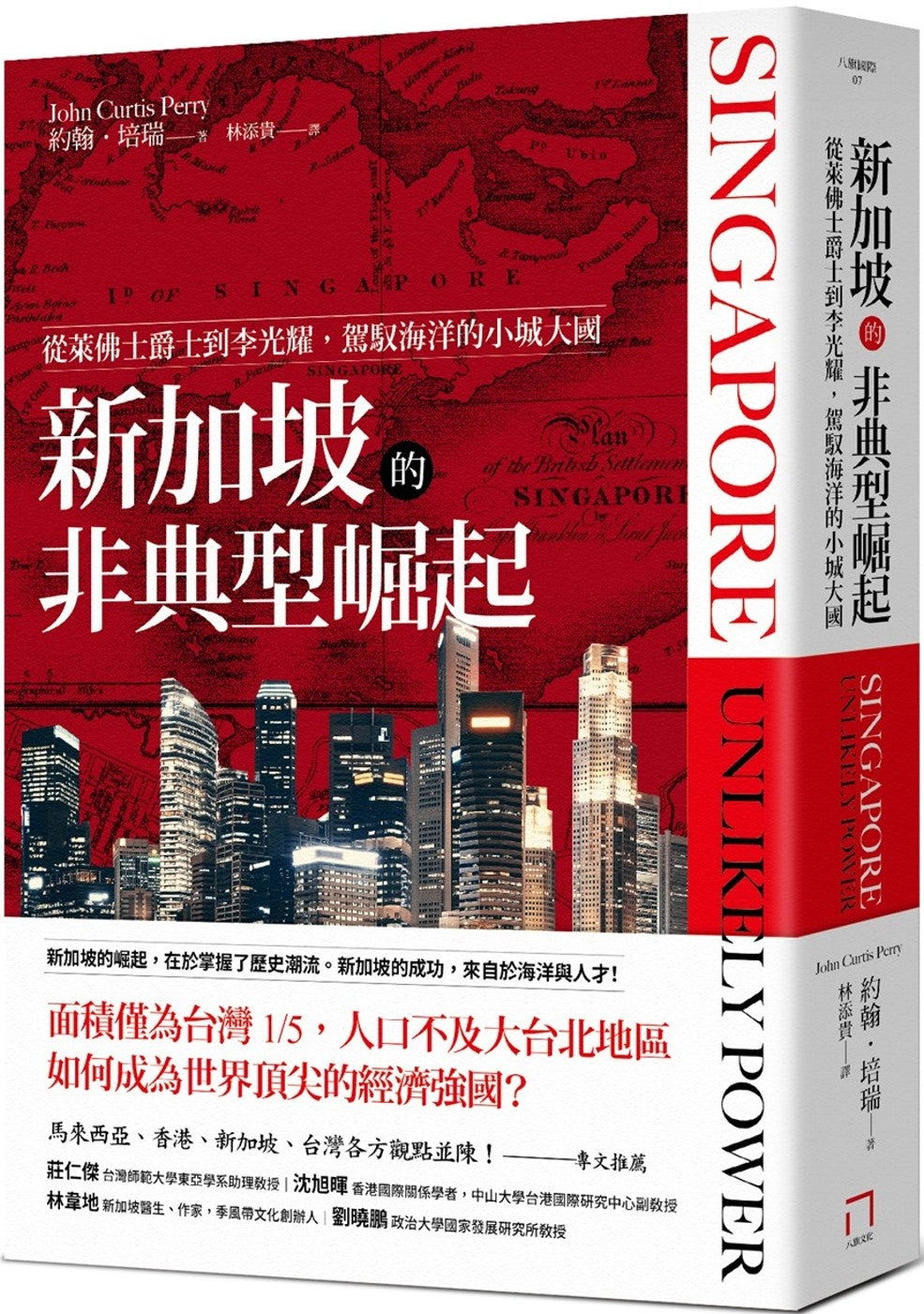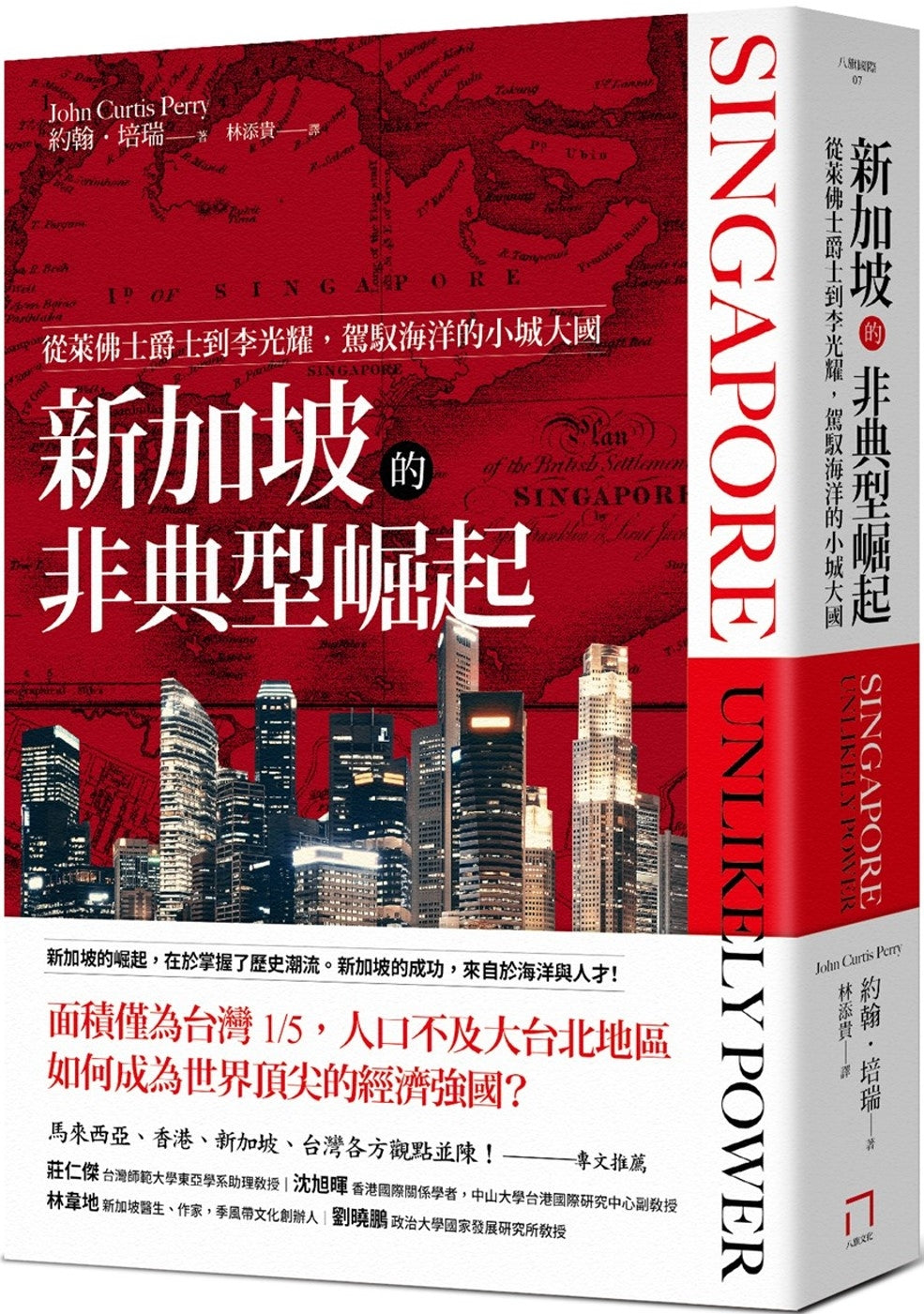Singapore's Unconventional Rise: From Sir Stamford Raffles to Lee Kuan Yew, a Small City-State Riding the Oceans (Newly Revised Edition)
Singapore's Unconventional Rise: From Sir Stamford Raffles to Lee Kuan Yew, a Small City-State Riding the Oceans (Newly Revised Edition)
1 in stock
Couldn't load pickup availability
出版社: 八旗
ISBN/EAN: 9786267234501
出版日期: 2023-08-02
页数: 448页
语言: Traditional Chinese
☆The most barren resources create the greatest wealth!
☆The most remote area gives birth to the most modern society!
☆The most complex ethnic group gives birth to the most efficient government!
How could such a tiny country become a world-class power?
Singapore's rise lies in its grasp of the historical trends of the 21st century.
Singapore’s success comes from the ocean and its talents!
Singapore's land area is just over 700 square kilometers, roughly one-fiftieth the size of Taiwan, and its population, at just over 5.4 million, is smaller than Taipei and New Taipei City combined. Yet, Singapore is a leading global hub for shipping, trade, finance, and education. Half of the world's annual maritime trade passes through the Strait of Malacca, and its ports handle approximately 500 million tons of cargo annually. Singapore's economic strength and human development index rank among the highest in the world, with a per capita GDP of US$72,000. It is the third largest international financial center in the world and the largest in Asia. The Financial Times calls it the "Zurich of the East," and The Economist ranks it first globally for overall ease of doing business.
Yet, all this was hard-won. When Singapore was forced to gain independence from Malaysia in 1965, few expected it to survive in such a hostile environment. Singapore had nothing. It lacked a hinterland, insufficient natural resources, and a limited labor force. Its short history, combined with a complex mix of ethnicities, languages, and beliefs, made it difficult to forge a national identity. Resource scarcity, economic stagnation, foreign invasions, and internal ethnic conflict threatened to scuttle this emerging nation at any moment. Yet, Singapore persevered. It not only became the most developed city in the equatorial zone, but also rose to become a world-class small-city power.
Singapore's success stems from two key factors. The first is its maritime presence. Singapore's strategic location, midway along the trade routes from Europe to China, makes it a prime location for resupplying ships, staging and distributing cargo, and resting sailors. Combined with its peaceful deepwater port, these geographical advantages have long made it the world's largest container port.
The second is human wisdom and determination. From 1819, when Stamford Raffles of the British East India Company persuaded the British Empire to seize Singapore from the Dutch and develop it into a trading post for China, to Lee Kuan Yew leading Singapore out of the shadow of "forced independence" and towards independence, all of this was achieved through the painstaking planning, strong will, and swift action of visionary politicians.
In Singapore's Unconventional Rise, Professor John Perry, a global maritime historian, traces the footsteps of immigrants, pirates, merchants, and conquerors from the 14th and 15th centuries, through the Age of Exploration, British rule, Japanese occupation, and finally independence. He describes how this small island, embracing a diverse ethnic group and a world of goods, capital, and ideas, leveraged its maritime advantages under the business acumen of the Chinese and the exceptional rule of the British to achieve the ideal of "creating a First World oasis in a Third World desert."
This book cites numerous factors contributing to Singapore's rise, including its strategic location, historical coincidences, multiculturalism, flexible yet pragmatic political decisions, a willingness to forgive past sins for the sake of the future, and a commitment to fostering an environment that attracts international investment through the recruitment of talented individuals. As the author observes, Singapore is no utopia, but its story is captivating and full of hope. For anyone interested in Southeast Asia, navigation, global commerce, and leadership, "Singapore's Atypical Rise" is a must-read.
John Curtis Perry
Professor of Maritime History and Founding Director of the Maritime Studies Program at the Fletcher School of Law and Diplomacy, Tufts University, an expert in East Asian and Pacific studies, and founding chair of the Institute for Global Maritime Studies.
Perry's research covers Asia-Pacific relations with the United States, the US occupation of Japan, and US expansion in the Pacific. He has written numerous books and papers, earning acclaim for his ability to explain complex historical contexts to a general audience with clarity, conciseness, and wisdom. In 1991, he was awarded the Order of the Sacred Treasure, a Meiji-era award, by the Japanese government in recognition of his contributions to US-Japan relations.
He is the author of books such as Beneath the Eagle's Wings, Sentimental Imperialists, and Facing Wes.
Lin Tiangui
A graduate of the Department of Diplomacy at National Chengchi University and the Department of Political Science and Graduate Studies at National Taiwan University, he has served as a senior corporate executive and senior editor for news media. He has translated over 100 books, including "Taiwan's China Dilemma: The Cross-Strait Economic and Trade Dilemma Under the Context of Taiwanese Identity," "Fear: Trump in the White House," "China's Expansion: How History Shaped China's Path to Power," "The Truth About the Base Empire: Visits to Over 60 US Overseas Military Bases and Rethinking Their History, International Politics, and Social Issues," "How Did America Lose the World?: The Fatal Mistakes of US Foreign Policy in the Post-Cold War Era," "The Path America Should Have Taken: How Obama Resisted Washington's Political Infighting and Redefining America's Relationship with the World," "The South China Sea: Asia's Powder Keg in the 21st Century and China's First Step to Asian Domination," and "The 2049 Hundred-Year Marathon: China's Secret Strategy for Global Domination."
New Edition Foreword: Malaysia’s Perspective: The Most Familiar Neighbor – Singapore in the Eyes of Johor Bahru People Foreword (I) Hong Kong’s Perspective: If Singapore is not considered a miracle, are there any other miracles in the world?
Foreword (II) Singapore’s perspective: Smallness is Singapore’s greatest advantage, but its heart is huge Foreword (III) Taiwan’s perspective: The rise and fall of great leaders Preface Chapter 1: The Power of the Ocean Chapter 2: The Struggle for Maritime Power Chapter 3: After the Far East Chapter 4: The Empire at its Peak Chapter 5: World War: Clouds, Thunder, and Storms Chapter 6: Walking on a Razor’s Edge Chapter 7: Being Sweeped Out Chapter 8: Coming to the Present Chapter 9: Towards a Global Hub Acknowledgements and Notes
Share


